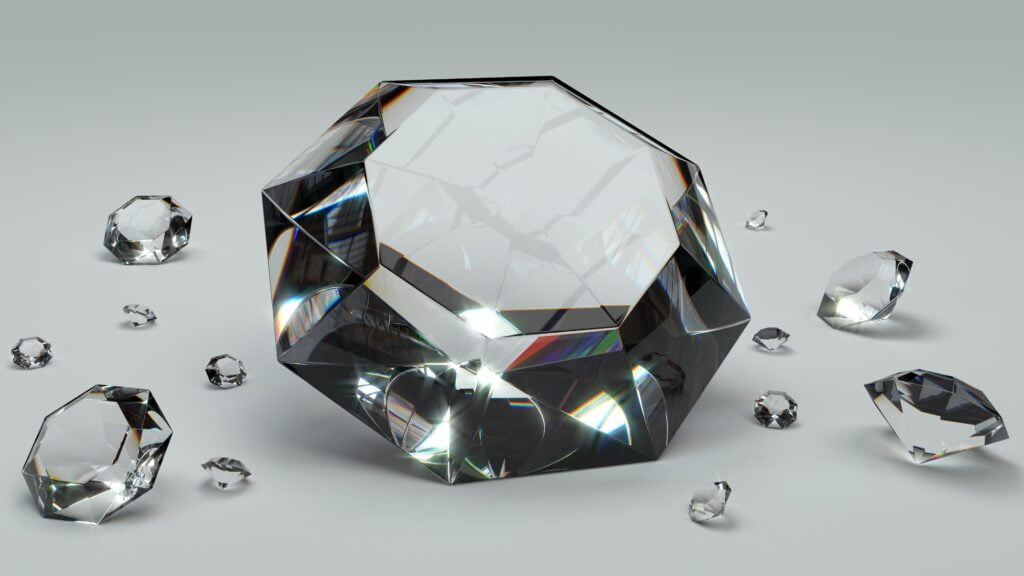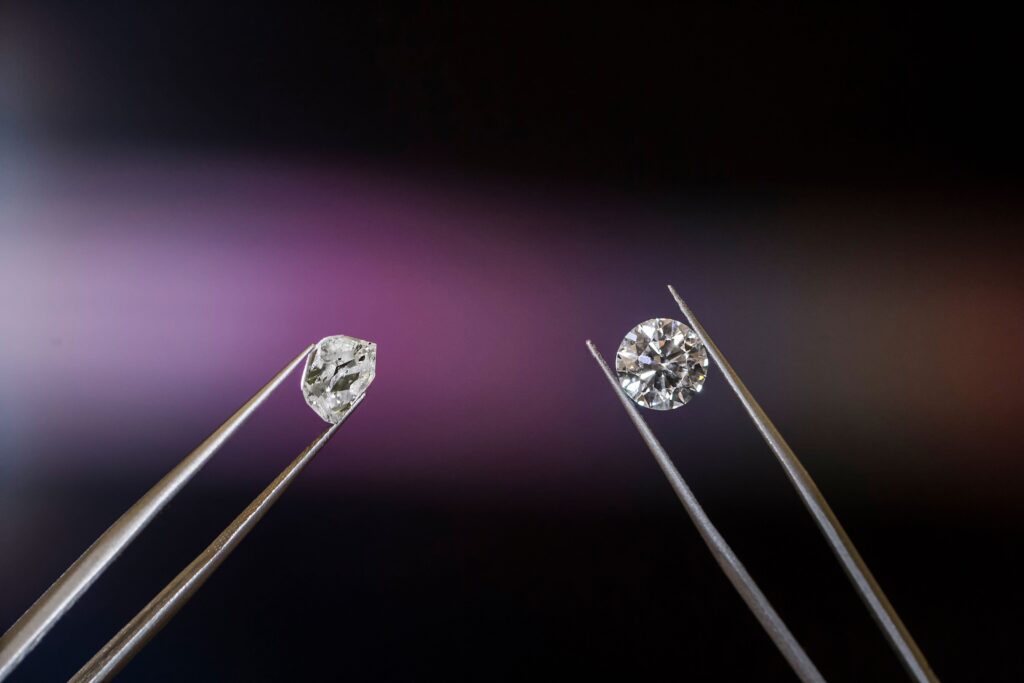Why Are Real Diamonds So Expensive

Why Are Real Diamonds So Expensive : Due to their enduring beauty and dazzling appeal, diamonds have attracted people for centuries. However, beyond their obvious beauty, many people have wondered: why are real diamonds so expensive? The fascinating world of diamonds and the reasons behind their exorbitant price are the subjects of this piece.
Rarity and Scarcity:
The scarcity of diamonds is the fundamental factor that determines their value. Under extreme heat and pressure, diamonds were formed in the Earth’s mantle millions of years ago. Due to this inherent process, diamonds are extremely rare, with only a small percentage of diamonds mined being considered of gem quality. Since demand is much higher than supply, the scarcity factor increases their value significantly.
Natural Formation Process:
An extremely hot and pressurized natural process occurs beneath the Earth’s crust to form diamonds. Carbon atoms join together to form diamond crystals through a process called “crystallization”, which takes millions of years. But this natural process is quite selective, so only a small fraction of the carbon atoms actually produce diamonds that are large enough to wear as jewellery. The geological uniqueness of diamond-bearing locations is a major contributor to their extreme rarity and scarcity.
Limited Gem-Quality Production:
Only a small percentage of the diamonds mined are of gem quality, even though the diamond mining industry is massive throughout the world. Diamonds that meet gem quality standards in terms of clarity, color, cut and carat weight are ideal for making jewellery. Rather than being worn as jewellery, most mined diamonds are industrial grade, used in a variety of technical contexts. Due to the rarity of diamonds cut for jewelry and the fact that they are classified as gem-quality or industrial-grade, there is a significant price premium for them.
Finite Supply and Increasing Demand:
The demand for real diamonds is increasing around the world, yet the supply is limited, so they are extremely rare and expensive. More diamond deposits may be found in the future, but the rate of discovery is low compared to the demand for diamonds in jewellery. Additionally, the demand for luxury goods such as diamonds is increasing due to the growing middle class population and emerging economies. The already high price of diamonds is becoming even higher as the demand for them continues to increase.
Geopolitical and Environmental Factors:
The availability of diamonds is also affected by geopolitical factors and environmental constraints. Some areas rich in diamond deposits may experience political instability or violence, making it difficult to exploit these resources. Bans on diamond mining may also be due to environmental concerns about the techniques, such as habitat loss and pollution of water sources. All these things together make diamonds even rarer and rarer.
In light of the above, it is clear that the scarcity and rarity of genuine diamonds is caused by the complex interplay of natural geological processes and human activities. Due to their innate rarity, diamonds are extremely valuable and sought after by people all over the world.
Labor-Intensive Mining Process:

Extracting diamonds from mines is not an easy task. Working in the mining industry requires a lot of physical labor, high-tech equipment, and careful attention to safety protocols. Digging into mountains of rock and dirt in search of diamond deposits is a dangerous and difficult task. The overall cost of production has further increased as diamond mining businesses invest heavily in exploration and infrastructure.
Table of Contents
Quality Assessment and Grading:

Determining the quality of a diamond requires an expert opinion because not all diamonds are the same. Cut, clarity, color, and carat weight are the “4 C’s” that gemologists use to carefully evaluate a diamond. Only the most extraordinary diamonds undergo this rigorous grading process and reach the hands of consumers as precious gemstones. As a result, because of their rarity and attractiveness, exceptional quality diamonds command high prices.
The Four Cs:
The “four Cs” – carat weight, cut, clarity and color – are the cornerstone of diamond quality evaluation. All of these things are very important when deciding how much a diamond is worth.
- Cut: A diamond’s cut determines its shine and brilliance through its dimensions, symmetry, and polish. Perfection in the cutting of a diamond enhances its resale value and aesthetic appeal by making the stone more dazzling.
- Clarity: The clarity of a diamond determines whether it has internal flaws (inclusions) or external imperfections (flaws). The rarity and aesthetic purity of diamonds increases their prices, and higher clarity ratings are a direct result of this.
- Color: Colorless diamonds are ranked as D on the scale, while light yellow or brown diamonds are ranked as Z. Due to their increased brilliance due to the increased amount of light flowing through them, colorless diamonds are more expensive and uncommon.
- Carat Weight: One carat is equal to 200 milligrams, which is the standard unit of measurement for diamond size. Although other criteria such as cut, color, and clarity also affect the total value, larger diamonds generally command a higher price due to their rarity.
Expert Grading and Certification:
Certification as a gemologist is generally required to accurately evaluate the quality of a diamond. To establish a diamond’s grade as per industry standards, these experts carefully inspect it using sophisticated equipment and methods.
- Gemological Laboratories: The Gemological Institute of America (GIA) and the International Gemological Institute (IGI) are trusted independent gemological laboratories that grade diamonds. Diamonds that receive certification from these laboratories are rigorously tested and come with official paperwork confirming their high quality.
- Grading Reports: Certificates and grading reports reveal not only the diamond’s cut, clarity, color, and carat weight, but also its symmetry, fluorescence, and other unique properties. With the help of these studies, consumers can be assured that the diamond they are purchasing is of high quality and genuine, leading to more reasonable prices.
Impact on Value and Pricing:
The market value and pricing of diamonds is greatly influenced by the quality evaluation and grading processes.
- Premium for High-Quality Diamonds: Due to their rarity and aesthetic appeal, diamonds with excellent cut, clarity, color and carat weight attract premium prices. Due to the fact that high quality diamonds command premium prices, grading and quality evaluation are the cornerstone of diamond value.
- Market Transparency and Consumer Confidence: The credibility of the diamond industry and the trust of its customers are strengthened by honest grading practices and reliable certification. Buyers can rest assured that they will get diamonds of the desired grade and value thanks to grading reports, which offer standardized quality evaluations.
Things like a diamond’s cut, clarity, color and carat weight are all the most important quality evaluation and grading criteria that help determine its price. Trust and openness in diamond trade is promoted by expert grading and certification, which ensures the quality and authenticity of diamonds.
Supply Chain and Distribution:
A diamond must go through a long and winding process to get from the mine to the market. Each step in the diamond supply chain – from miners to cutters to polishers to distributors to retailers – adds its own markup. Additionally, the diamond supply chain is affected by ethical concerns and strict restrictions, which in turn affects pricing and expenses.
Marketing and Branding:

When it comes to allure, the marketing and branding power of diamonds is just as powerful as their physical characteristics. Diamond businesses pour a lot of money into advertising efforts, portraying the diamond as a symbol of love, devotion and opulence. Such strategic branding makes people consider diamonds as romantic and a status symbol, thereby increasing their price and demand.
Conclusion:
Why Are Real Diamonds So Expensive : In conclusion, real diamonds are so expensive because of many things, such as their scarcity, the difficulty of mining them, the rigorous standards for their quality, the complex logistics of their supply chain, and the persuasiveness of its marketers. Diamonds may be one of the most expensive gemstones on the market, but their classic good looks and eternal romance keep them at the top of the gemstone market.

